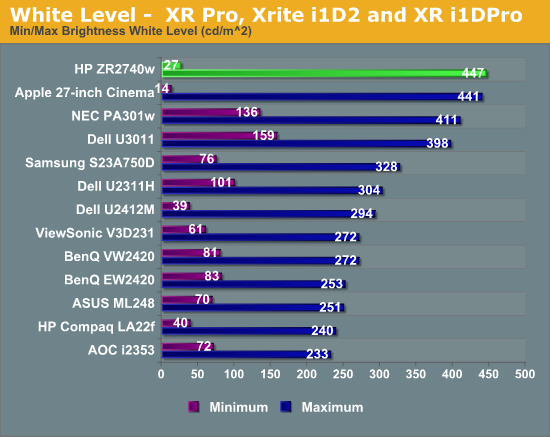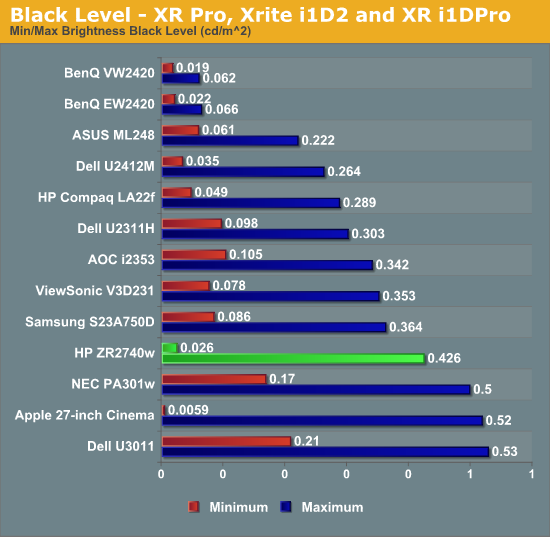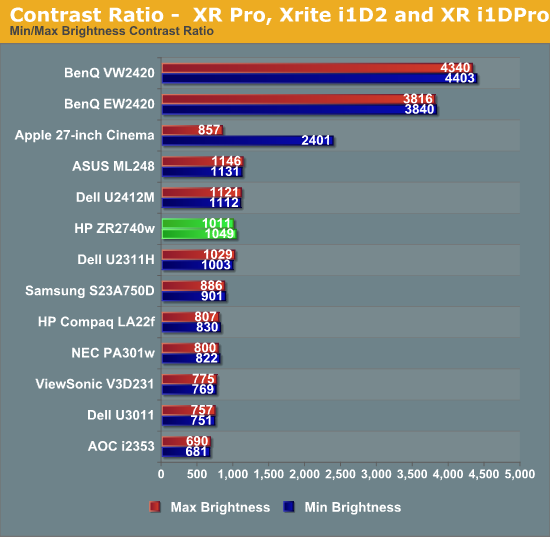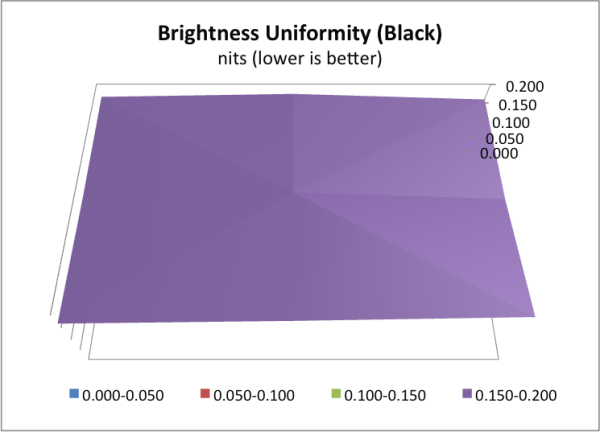HP ZR2740w - High Resolution IPS that Doesn't Break the Bank
by Chris Heinonen on March 16, 2012 1:15 AM ESTBrightness and Contrast
Is your work environment bright? Are there massive spotlights behind you that shine directly onto your screen? Well, don’t worry; the ZR2740w will produce more than enough light for you. I’d expect screens to get a little dimmer as the size gets larger, since a backlight would need to be more powerful and more expensive to light it up, but apparently that is not the case. The HP managed to put out almost 450 nits of brightness when turned up all the way, which is plenty for anyone no matter what their work environment.

I can only assume that to evenly light up a 27” or larger LCD panel, vendors need to use larger, more powerful backlights and it is as easy to use one that does this much brightness as one that only does 250 nits of light, but I’m going to say this is a good thing. The downside to a larger light is that it might cause the black levels to be higher than on other displays, and that does seem to be the case here with the HP.

The black levels on the HP are higher, but they are right in line with other 27” and 30” displays, so it really is a middle of the road result for it. Given the cost difference between the displays, that the HP equals them in performance is very nice to see on here. One area that the larger panels fell behind in was contrast ratio, where they only manage around 750:1 which is a little disappointing given their cost. The HP manages to exceed this, offering over 1,000:1 at both maximum and minimum brightness levels.

The only high resolution display we have tested that can exceed this is the Apple Cinema Display, but it only does that at peak brightness as the contrast ratio falls off at lower light levels. The more consistent results from the HP gives it the best contrast of any high resolution display currently tested in my mind. Of course a larger panel also means a higher chance of uniformity issues, so hopefully the powerful backlight is able to correct for that.
There is certainly a bright spot in the center of the screen and fall-off around the edges, but the variance comes in at a very respectable 4.67%, which outperforms many smaller panels. The black uniformity also comes in very well, with just 6.6% variance. Of course I’d expect the black level to perform better since the higher black level in general will lead to a smaller variance percentage, even if the amount of variance is higher. To account for that, I’ll start to report the percentage for the white uniformity, since that target is always 200 nits, and the actual variance for the black level, in this case 0.011 nits, as we target the minimum level for black. I wish the units were the same so it was easier to compare, but to do that we would have to have a black level target, which would hurt displays that can do a lower level of black than others.












119 Comments
View All Comments
paohyean - Friday, March 16, 2012 - link
Nice monitor..I own a U2311H and I like the included USB Hub..
I just attach my webcam, Bluetooth key and wireless keyboard/mouse receiver onto it..
Reduces a lot of the cable clutter..
EnzoFX - Friday, March 16, 2012 - link
The first/early HP 30" displays did the same thing with handling the input, I don't think it scaled though. Anyways, it made for great low input lag. I remember it being one of the lowest if not the lowest for IPS displays, and probably still is, since now you have pretty advanced features and scaling stuff. I love the idea of this. I suppose I could simply rely on something else when I really need input flexibility. I only dislike the bezel HP uses =P.EnzoFX - Friday, March 16, 2012 - link
*since you have more advanced features/input handling/scaling stuff these days... I meant to say.darkswordsman17 - Friday, March 16, 2012 - link
http://hardforum.com/showthread.php?t=1675393Comes with caveats though (eBay sellers, they ship from Asia, so returns/exchanges are gonna be a pain), but seems most people are having pretty good experiences.
Zoomer - Friday, March 16, 2012 - link
Also a lower binned panel (A-) vs A++.ypsylon - Friday, March 16, 2012 - link
Running it for some time now. Bought it for equivalent of 830 USD but that is the problem with products coming from USA to Europe. Oh joys... ;pBest LCD I ever owned. The only problem I can't find with it is too high lumination - 380cd. Far too much for IPS matrix. 250 cd should be more than enough. Despite that I still love it. Lack of OSD - not an issue after calibration. Running it at lowest lumination. 99.9% imaginable task can be done at this settings. But when you crank up brightness (if you doing CAD or 3D modeling) then it hurts eyes, still it is better than 30" model from the same family which uses CCFL not LED. I was split between Dell 27" and this little beast. Went with HP for 3 main reasons: LED not CCFL, smaller power drain, pivot. For those who whining that matrix is too slow for gaming blah, blah, blah. Have you ever played with monitor equipped with matrix different than TN? 10-12ms on IPS with 1000:1 is perfect matrix. Never, not once noticed any problem with that setup. Games, movies, job. It deals perfectly with anything I can think of. Response time is important with TN. While marketing slogans on TN shout : Response time: FTL or Contrast ratio: 958000000:1. That stuff is only for idiots. Like I said. HP ZR2740w is excellent, not perfect, but still supremely fine product. I'm not a person who will whine about it being 16:9 and not 16:10. A non-issue for me, and I never was interested in 120Hz model.
JohnBooty - Friday, March 16, 2012 - link
"The only problem I can't find with it is too high lumination - 380cd. Far too much for IPS matrix. 250 cd should be more than enough."Do LED backlights get dimmer over time, like CCFL backlights?
With CCFLs, you definitely want to buy one with more illumination than you'll ever need, since the maximum brightness will fade considerably over time - the 300cd CCFL monitor you buy today might only be able to produce 200cd after a few years of heavy use.
But I'm unclear as to whether this is an issue with LED backlighting.
Tetracycloide - Friday, March 16, 2012 - link
LEDs definitely fade over time. They're supposed to last longer than CCFLs though but I'm not sure what that means in terms of illumination. Assuming they fade at the same rate relative to their lifespan it means LEDs will fade but fade more slowly but that's a pretty big assumption. Your guess is probably as good as mine but I can say for certain that LEDs do fade.Swirlser - Friday, March 16, 2012 - link
My apple 30s are 6 or 7 years old now, so those res's have been around quite a bit more than a few years.Pretty cheap looking and performing monitors, but I guess they are priced as such. So an adequate option for those not pushed on finer details.
(wish apple didn't stop making the 30s, hate to think that a decade on when I need new monitors I'll possibly be downsizing!)
Tchamber - Friday, March 16, 2012 - link
I have this unit's little brother, the ZR24, and I love it. Viewing angles are great from this line. I do like that mine has an OSD, though. I think it's funny that the OP said it's too much money for a 16:9 monitor, when it has much more resolution than 99.9% of monitors out there :) people always say 1920x1080 is too little, now 1440 is too little too...